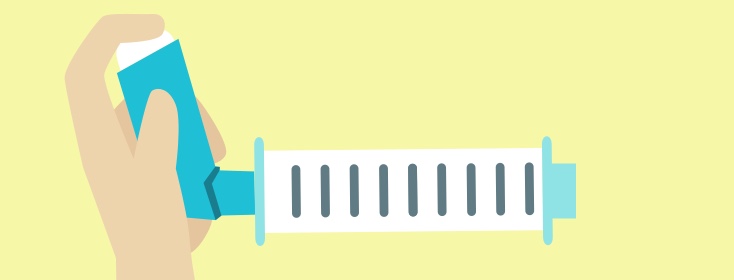Spacers and Techniques for Using Them
Many people in the COPD.net community talk about "spacers" when discussing treatment, but there are also many people in the community who have never heard of spacers, and naturally, want to know what they are. Before we talk about spacers, though, we have to take a step back and discuss the drug delivery mechanisms that use aerosols.
What are drug delivery mechanisms that use aerosols?
Drug delivery mechanisms using aerosols are an integral part of the treatment of respiratory disorders such as COPD. Metered dose inhalers (MDIs), dry powder inhalers (DPIs), and small volume nebulizers (SVNs), are the most popular modes of aerosol delivery.
The advantages of aerosol drug delivery systems are a faster onset of pharmacological action, since the drug is being delivered to the site that needs the medicine. With a lower systemic bioavailability, the potential for adverse side effects is reduced, since there is minimal to no systemic involvement.
A metered dose inhaler (MDI) is a handheld aerosol device that uses a propellant to deliver the medicine. MDIs are typically comprised of a pressurized metal canister that includes the medication, a propellant and a metering valve.
How can a spacer help with these treatments?
Spacers attempt to address the problem of patient coordination between device actuation and the inhaled breath. Another type of spacer is the valved holding chamber (VHC). The VHC allows for a fine cloud of medication to stay in the spacer until the person breathes it in through a one-way valve. This breath then draws the dose of medication into the lungs.
Spacers and holding chambers extend the mouthpiece of the inhaler and direct the mist of medication toward the mouth, reducing medication lost into the air.
How do COPD patients use spacers?
The proper technique for using an MDI with a spacer is:
- Take the cap off the inhaler and spacer.
- Shake the inhaler vigorously.
- Attach the spacer to the inhaler.
- If you have not used the inhaler in a while, you may need to prime it. See the instructions that came with the inhaler for how to do this.
- Breathe out gently and completely to empty your lungs.
- Put the spacer between your teeth and close your lips tightly around it.
- Keep your chin up.
- Start breathing in slowly through your mouth.
- Spray 1 puff into the spacer by pressing down on the inhaler.
- Continue breathing in slowly. Breathe as deeply as you can.
- Take the spacer out of your mouth.
- Hold your breath as you count to 10, if you can. If not, hold your breath for as long as you are able.
- Pucker your lips and slowly breathe out through your mouth (use the pursed lip breathing technique where possible).
- After using the inhaler, rinse your mouth with water, gargle, and spit (do not swallow!). This helps reduce side effects from the medication.
Suggestions for spacer use
- Only use the spacer with a pressurized inhaler, not with a dry-powder inhaler.
- Spray only one puff into the spacer at a time.
- Use the spacer as soon as you've sprayed a puff into it.
- Never let anyone else use your spacer.
- Keep the spacer away from heat and heat sources.
- If the spacer has a valve that is damaged, or if any other part of the spacer is damaged, do not use it. The spacer will have to be replaced.
- Some spacers have a whistle. Your inhalation technique is fine if you do not hear the whistle. However, if you hear the whistle, this means you should slow your inhalation breath down.
It is very important that you consult your doctor, or other healthcare professional, to review proper technique for the use of the MDI and spacer.

Join the conversation